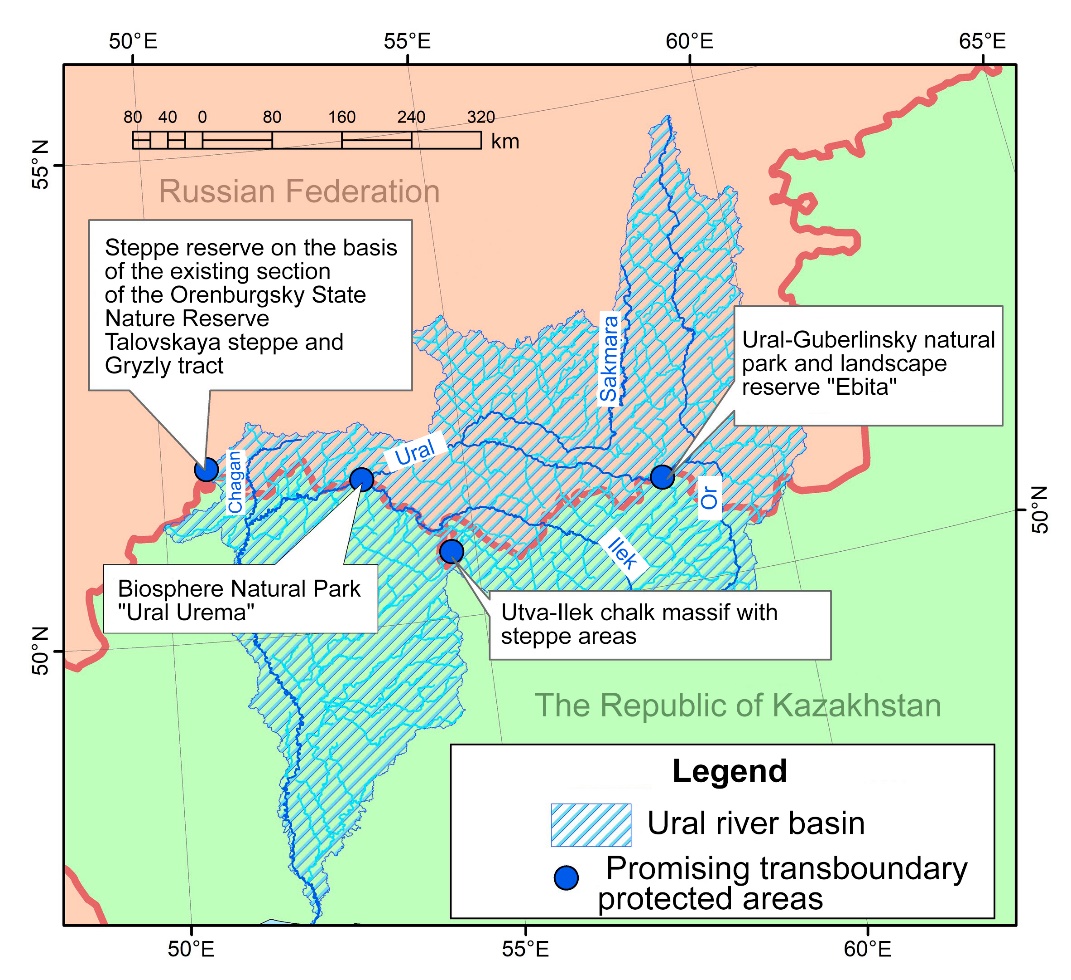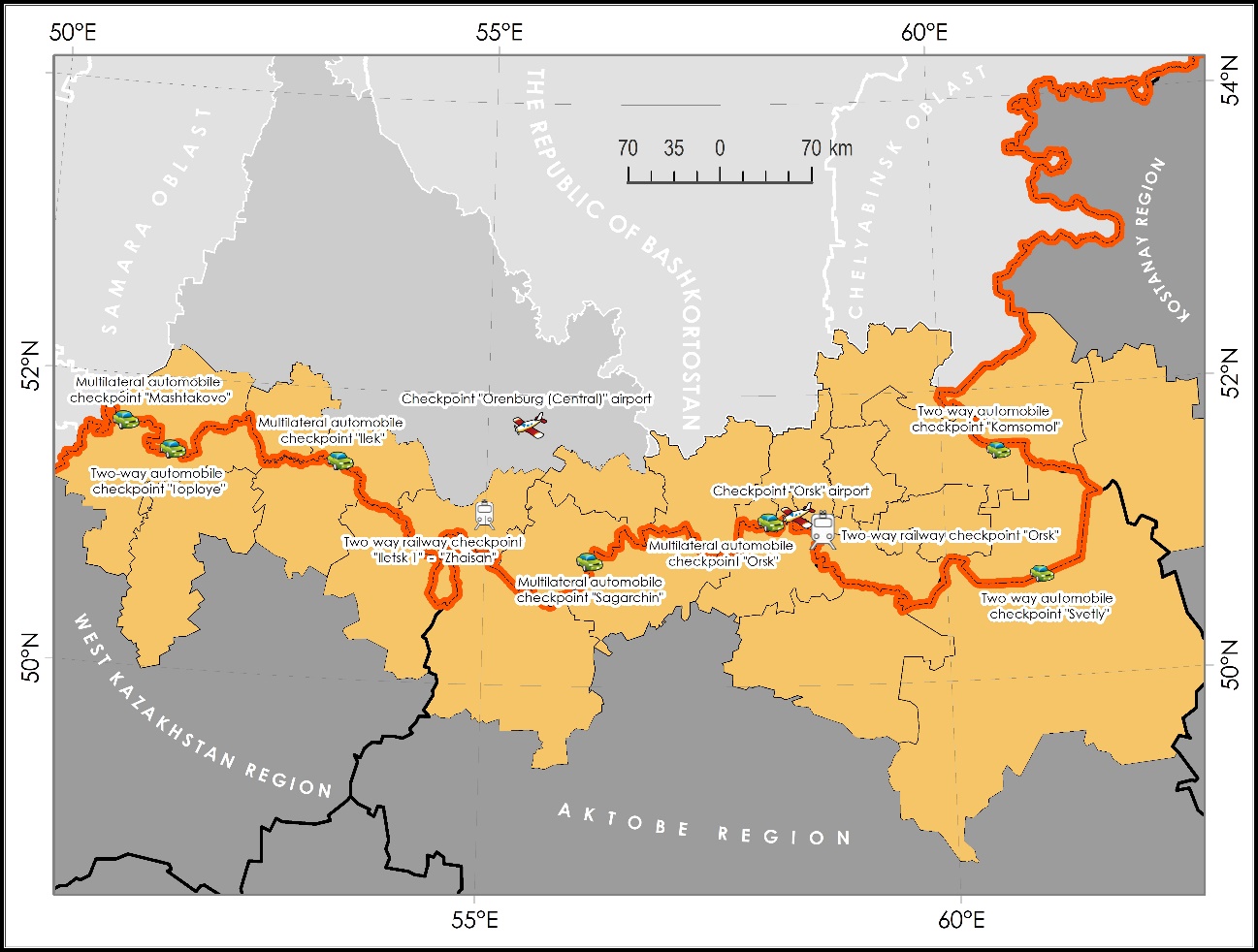Abstract
The development of cross-border tourism has become more and more popular within the European Union through the Interreg programs. On the territory of the CIS countries, cross-border tourism is poorly developed due to difficulties in crossing state borders and poorly developed tourist infrastructure. For three centuries, the Orenburg-Kazakhstan cross-border region has been a single historical-geographical, ethnic, ecological, economic space. All these factors meet the criteria for the development of cross-border tourist areas: unity, complementarity, contrast, uniqueness of natural, historical, cultural and social factors. The indicators of the bilateral tourist flow between Russia and Kazakhstan, as well as the analysis of tourism development strategies of two states allow us to conclude that the development of cross-border tourism in the region under study is promising. The most promising types of tourism include shopping tourism, medical tourism, educational tourism, business tourism, historical, cultural and ecological tourism. Ecological tourism, in addition to being a key point in the tourism development in Kazakhstan, is of particular importance in cross-border regions. Cross-border tourism is a promising area of cooperation; however, it is not popular in the Orenburg-Kazakhstan region. For the full use of cross-border recreational resources, it is necessary to develop an infrastructure and improve its comfort. This should be facilitated by the integration interaction between Russia and Kazakhstan within the Eurasian Economic Union.
Keywords: Cross-border tourism, Orenburg-Kazakhstan cross-border region, SPNA
Introduction
Tourism is one of the most dynamic sectors of the world economy; it contributes to the increase in the gross domestic product and provides people with jobs.
The most characteristic trends in the tourism development include the expansion of the range of tourist destinations, as well as the diversification of tourist products.
A special type of tourism – cross-border tourism – is gaining popularity. It has been developing in recent decades, especially within the European Union through the Interreg programs. On the territory of the CIS countries, cross-border tourism is not developed due to difficulties in crossing state borders, as well as the lack of an integrated tourist infrastructure.
2020 turned out to be a difficult year for the tourism industry; due to the coronavirus pandemic, the state borders were closed. Under these conditions, reasonable and justified import substitution should become one of the priority directions for the development of the tourist and recreational sphere of the Russian Federation. This is especially true for transboundary regions with unique natural and cultural landscapes, including Orenburg region.
It is worth distinguishing between the concepts of border regions and cross-border regions. A transboundary region is a border region characterized by a certain natural (similarity of landscapes, natural conditions), socio-economic, cultural and historical unity.
Thus, the Orenburg-Kazakhstan cross-border region has been a single historical-geographical, ethnic, ecological, economic space (Chibilev, 2011). All these factors meet the criteria for the formation of transboundary tourist areas identified by Soldatenko (2015): unity, complementarity, contrast, uniqueness of natural, historical, cultural, social and other factors.
Orenburg region has the longest section of the Russian-Kazakh border. The development of tourism in the Orenburg-Kazakhstan cross-border region should contribute to the activation of socio-economic processes on both sides of the border and can be a tool for preserving the common natural, cultural and historical heritage of the region.
The cross-border tourism in the Orenburg-Kazakhstan region will meet the demand for recreational services of residents of the cross-border region, create an attractive and competitive offer in the tourism and recreation sector for residents of other regions of Russia and foreign citizens and provide conditions for economic growth of the region. Cross-border tourism can create the basis for the preservation of natural and cultural and historical heritage of the region. It is a unique tool that contributes to the solution of socio-economic problems, improves the economy, develops the regional infrastructure, creates jobs and increases living standards of the local population by increasing investment in the region.
Problem Statement
The European cross-border regions are the most effective and well-studied regions. It is the experience of European integration, cross-border cooperation. However, the Russian-Kazakh borderland differs from the intensively developed and densely populated border areas of European countries. Transboundary regions, being on the periphery, are marginal. Most of the Russian-Kazakh border belongs to this type. As the Russian geographer Zyryanov (2013) points out, the tourist and recreational direction is one of the most promising for the development of marginal territories. With the help of tourism development, these territories can be turned into recreationally developed regions. Different parts of the cross-border region are competitors in attracting tourists. Therefore, the unification of such regions into a single cross-border region can turn former competitors into employees.
Research Questions
State borders and their barrier function are the main constraints in the development of cross-border tourism. Despite the great interest in the problems of state borders on the part of geographers, sociologists and anthropologists, the literature on tourism pays little attention to the role of borders in the development of tourism.
Literature review
A large number of articles have been written about the importance of cross-border tourism, mainly in Europe. The authors have studied various components of cross-border recreational systems (for example, cross-border tourist routes (Stoffelen, 2018)), analyzed factors that influence the intensity of tourist flows across the borders. A large number of works are devoted to the boundaries, their barrier function and the degree of permeability (Kim & Bramwell, 2019) and Matilainen et al. (2018).
Regional studies describing the bilateral experience of states in the field of regulation of cross-border tourism are of particular interest. The article by Makkonen et al. (2018) is devoted to cooperation in the field of tourism on the Finnish-Russian border; Kozak and Buhalis (2019) wrote about the arketing policy in the development of tourism in Greece and Turkey. The article by Stoffelen et al. (2017) is devoted to the German-Czech border.
Until 2015, in Russia, there were no articles on cross-border tourism.
Trends in the development of tourism in Kazakhstan and Russia
In 2018, by the number of foreign tourists who entered Russia, Kazakhstan ranked second. As can be seen from Figure 1, 3.5 million tourists from Kazakhstan enter Russia annually. Kazakhstan is the fourth most popular destination for Russia.

Currently, in Kazakhstan, Russian tourists are the second largest category of foreign tourists. For the people of Kazakhstan, the most popular destination is Russia. It can be concluded that both countries play a significant role in each other's inbound tourism.
As for the strategy of tourism development in Kazakhstan, the conceptual approach to the development of tourism is based on the "four E": – eco, ethno, entertainment, event. In the Concept for the Development of the Tourism Industry of the Republic of Kazakhstan until 2020, there are no clear tasks for the development of tourism in cross-border regions, but there are a number of issues affecting tourism in border regions, in particular, weekend tours, transport corridors Western Europe – Western China (the Silk Road), improvement of the infrastructure of border stations.
The strategy for the development of tourism in the Russian Federation for the period up to 2020 includes a project for the development of a transboundary tourist cluster "Eastern Gate of Russia Zabaikalsk-Manchuria". There is very little information about the project itself and the course of its implementation. Within this project, the world's longest international tourist route "The Great Tea Route" was created; it is the most ambitious Russian project in the field of cross-border cooperation.
In the tourism development strategy in Orenburg region, the development of tourism in the cross-border region has not been covered, but there are several similar provisions on the subject. In particular, the need to simplify the entry of tourists from Kazakhstan and organize joint tours was identified.
The indicators of the bilateral tourist flow between Russia and Kazakhstan, as well as fundamental directions tourism development strategies of two states allow us to conclude that the development of cross-border tourism in the region under study is promising.
Purpose of the Study
The purpose of the study is to determine prospects for the development of tourism in the Orenburg-Kazakhstan cross-border region.
The main hypothesis is that cross-border cooperation between countries in the field of tourism is promising and provides regions with a number of opportunities: development of the tourism infrastructure; a shift in the emphasis towards sustainable tourism (the rational use of recreational resources); economic growth.
Research Methods
The study is based on comparative geographical, and cartographic methods and the method of expert assessments. The comparative-geographical method made it possible to assess the current state of cross-border tourism in the Orenburg-Kazakhstan cross-border region and determine the prospects for its development. The statistical method was used to study the dynamics of the tourist flow and determine the place of two countries in each other's inbound tourism.
Based on the results of field studies (sociological surveys, questionnaires and expert assessments) and taking into account a number of factors (recreational attractiveness, proximity of checkpoints), the authors identified the most attractive objects for the development of tourism in the Orenburg-Kazakhstan cross-border region.
Findings
The most promising types of tourism in the Orenburg-Kazakhstan cross-border region include shop tourism, medical tourism, educational tourism, business tourism, historical, cultural and ecological tourism (Sviatokha & Filimonova, 2020).
Let us start with the characteristics of shopping tourism, which is a trip aimed to visit shopping centers and gas stations. From Orenburg region, tourists go to Kazakhstan gas stations (due to the difference in prices), buy Kazakhstani alcoholic drinks (vodka, cognac), confectionery (chocolate, sweets), and tea. Kazakhstan citizens go to Orenburg region to buy cars.
For the purpose of medical tourism, Kazakhstan people go to Orenburg region to the inter-branch scientific and technical complex "Eye Microsurgery". This organization provides services to residents of Kazakhstan; for the convenience of patients, all inscriptions have been translated into Kazakh, oral announcements are given in Russian and Kazakh. The multidisciplinary clinic Medgard is also popular due to its convenient location.
70 kilometers from the border with Kazakhstan, there is a unique recreational facility – the Sol-Iletsk Lakes. Sol-Iletsk attracts Kazakhstan tourists by lake's mineral water, therapeutic mud and speleo cameras. One of the problems of development of the Sol-Iletsk resort is the lack of additional tourist services. The recreational infrastructure would solve this problem.
In addition, educational tourism has developed. In April 2019, Kazakh universities were presented in eight cities of the border regions of Russia, in Orenburg and Orsk. By 2021, the leadership of the Republic of Kazakhstan plans to attract over 50 thousand foreign students to Kazakhstani universities, most of them are Russian students.
Since the beginning of 2019, more than 180,000 foreign students have come to Russia to study. 33% of them are from Kazakhstan. Almost 2,000 Kazakhstan students study in Orenburg region (there are over 3% of Kazakhstani students in the Russian Federation).
Conferences, symposia, congresses, exhibitions are regularly held in the Orenburg-Kazakhstan cross-border region.
Historical and cultural tourism has great resources for increasing the tourist flow to the region (e.g., the "Great Silk Road").
Ecological tourism is of particular importance in cross-border regions.
Landscape-ecological expeditions along the Russian-Kazakh border conducted by the Steppe Institute of the Ural Branch of the Russian Academy of Sciences under the leadership of Academician Chibilev (2010), proved the existence of “the effect of increased biological and landscape diversity of border areas” (Chibilev & Grigorevskiy, 2017). In this regard, it becomes possible to create special transboundary reserves.
The need for diversified international cooperation between countries located in the transboundary river basins is beyond doubt. At the same time, in scientific research, the rational recreational use of natural resources within the basins of transboundary rivers is udenrstudied. Its main tool can be a unified network of protected natural areas.
Among the promising transboundary protected natural areas, scientists of the Steppe Institute (Chibilev, 2010) distinguish four main ones (Figure 2).

The configuration of the tourist route should be formed taking into account the cross-border transport and logistics framework of the territory based on the location of international checkpoints on the state border. Analyzing the recreational attractiveness and checkpoints of the Orenburg-Kazakhstan cross-border region (Figure 3), we can talk about the creation of a natural transboundary park in the Ural Urema region. This site is attractive and promising for the recreation development.

This part of the cross-border region is highly attractive. The river valley meanders, forming numerous floodplain lakes. There are relict plants, rare birds and animals.
The creation of a transboundary park on the territory of two or more states is a difficult task. Thus, political differences between neighboring states hinder cooperation. In addition, the creation of a transboundary park involves the joint control over parts of the territories of different states. Difficulties are also due to various environmental standards and laws of bordering countries. Russia and Kazakhstan have very favorable conditions and opportunities for creating a unified developed network of protected areas and transboundary recreational space, designed for the promising joint development of this territory (Chibilev, 2017).
Thus, when concluding intergovernmental agreements, it is important to envisage measures aimed to reduce the negative impact of transboundary rivers on the ecosystem and develop a unified network of protected areas in the river basin.
Cross-border tourism is the highest stage of recreation development in a cross-border region – a promising area of cooperation that has not yet been developed in the Orenburg-Kazakhstan region.
Conclusion
For the full use of the cross-border recreational potential, it is necessary to develop an equivalent infrastructure, improve its comfort on both sides of the border. This should be facilitated by the integration interaction between Russia and Kazakhstan within the Eurasian Economic Union. In particular, the basic principles of the strategy for progressive development of the Eurasian tourism organization in the field of international tourism cooperation include: “...development of a single Eurasian tourist space; assistance to the revival and development of traditional national tourism centers, development of new tourist areas with vast natural, historical and cultural resources; assistance in the implementation of the UN concept of sustainable tourism development as an environmentally safe application of natural and cultural resources; assistance in the development and implementation of advanced technologies in the Eurasian tourist space ... ".
The first step can be the implementation of a cross-border route. When designing cross-border tourist routes, it is necessary to regulate the border crossing procedure; unfortunately, despite the existing integration interaction between Russia and Kazakhstan, the state border retains significant barrier functions.
In addition, it is possible to organize international (Russian-Kazakh) ecological children's camps, whose advantage is the absence of a language barrier.
It is possible to create an internship base for students from Orenburg and Kazakhstan universities and involve students in tourism activities.
Cross-border tourism is an important tool for developing and strengthening international relations and cooperation. In addition, the highest form of recreation development – cross-border tourism – contributes to a more efficient and careful use of joint recreational natural and cultural resources, reduces infrastructure development costs, and promotes the cross-border region as a single tourist destination.
Cross-border cooperation is the most successful means of developing border areas. It is aimed at strengthening good-neighborly relations through treaties and agreements and joint projects.
Acknowledgments
This research was carried out as part of the state assignment AAAA-A17-117012610022-5.
References
Chibilev, A. A. (2010). Russian-Kazakh border subregion: problems of international environmental cooperation. In Near-border Transbound. Territ. Asian Russ. contiguous Ctries. (problems prerequisites Sustain. Dev (pp. 373–385). Novosibirsk.
Chibilev, A. A. (2011). Russian-Kazakhstan cross-border region: history, Geoecology and sustainable development. In Coll. monograph. Yekaterinburg: Inst. of the steppe of the Ural branch of the Russ. Acad. of Sci.
Chibilev, A. A. (2017). The origins and development paths of zapovednik management in Russia. Geography and Natural Res., 38, 211–216. DOI:
Chibilev, A. A., & Grigorevskiy, D. V. (2017). Integral Estimation Of The Trans-Border River Ural River Basin Regions’ Socioeconomic Modern Status. Fund. Res., 9–2, 487–492.
Kim, S., & Bramwell, B. (2019). Boundaries and boundary crossing in tourism: A study of policy work for tourism and urban regeneration. Tourism Manag., 75, 78–89. DOI:
Kozak, M., & Buhalis, D. (2019). Cross–border tourism destination marketing: Prerequisites and critical success factors. J. of Destinat. Market. and Manag., 14, 100392. DOI:
Makkonen, T., Williams, A. M., Weidenfeld, A., & Kaisto, V. (2018). Cross-border knowledge transfer and innovation in the European neighbourhood: Tourism cooperation at the Finnish-Russian border. Tourism Manag., 68, 140–151. DOI:
Matilainen, A., Suutari, T., Lähdesmäki, M., & Koski, P. (2018). Management by boundaries – Insights into the role of boundary objects in a community-based tourism development project. Tourism Manag., 67, 284–296. DOI:
Soldatenko, D. G. (2015). Transgraničnye territorii v turizme: teoretičeskie aspekty [Cross-border areas in tourism: theoretical aspects]. Nauka i turizm: strategii vzaimodejstvija [Science and Tourism: Interaction Strategies], 4(2).
Stoffelen, A. (2018). Tourism trails as tools for cross-border integration: A best practice case study of the Vennbahn cycling route. Annals of Tourism Res., 73, 91–102. DOI:
Stoffelen, A., Ioannides, D., & Vanneste, D. (2017). Obstacles to achieving cross-border tourism governance: A multi-scalar approach focusing on the German-Czech borderlands. Annals of Tourism Res., 64, 126–138. DOI:
Sviatokha, N., & Filimonova, I. (2020). Kumis treatment in the steppe regions as a promising direction of tourist nature management. E3S Web of Conf., 175, 10011. DOI:
Zyryanov, A. I. (2013). Teoreticheskie aspekty geografii turizma [Theoretical aspects of tourism geography]. Perm. gos. nats. isslled. un-t.
Copyright information

This work is licensed under a Creative Commons Attribution-NonCommercial-NoDerivatives 4.0 International License.
About this article
Publication Date
17 May 2021
Article Doi
eBook ISBN
978-1-80296-106-5
Publisher
European Publisher
Volume
107
Print ISBN (optional)
-
Edition Number
1st Edition
Pages
1-2896
Subjects
Science, philosophy, academic community, scientific progress, education, methodology of science, academic communication
Cite this article as:
Sviatokha, N. Y., Filimonova, I. Y., & Podosenova, I. A. (2021). Prospects Of Tourism Development In The Orenburg-Kazakhstan Transboundary Region. In D. K. Bataev, S. A. Gapurov, A. D. Osmaev, V. K. Akaev, L. M. Idigova, M. R. Ovhadov, A. R. Salgiriev, & M. M. Betilmerzaeva (Eds.), Knowledge, Man and Civilization - ISCKMC 2020, vol 107. European Proceedings of Social and Behavioural Sciences (pp. 1565-1573). European Publisher. https://doi.org/10.15405/epsbs.2021.05.207

